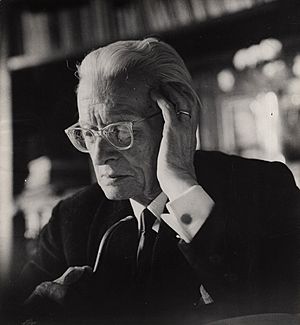Ildebrando Pizzetti facts for kids
Quick facts for kids
Ildebrando Pizzetti
|
|
|---|---|
 |
|
| Born | 20 September 1880 Parma, Italy
|
| Died | 13 February 1968 (aged 87) Rome, Italy
|
| Occupation | composer, musicologist, music critic |
| Era | 20th century |
Ildebrando Pizzetti (born September 20, 1880 – died February 13, 1968) was a famous Italian composer of classical music. He also studied music history (a musicologist) and wrote about music (a music critic).
Contents
A Life in Music
Ildebrando Pizzetti was born in Parma, Italy, in 1880. His father, Odoardo Pizzetti, was a pianist and taught him music from a young age. At first, Ildebrando thought about becoming a playwright and even wrote some plays. But in 1895, he decided to focus on music and joined the Conservatorium of Parma.
While studying, he learned from Giovanni Tebaldini. This teacher helped Pizzetti become very interested in early Italian music. This interest later showed up in his own compositions and his writings.
Pizzetti became a respected teacher himself. He taught at the Florence Conservatory and was its director from 1917 to 1923. Later, he directed the Milan Conservatory starting in 1923. From 1936 to 1958, he took over from Ottorino Respighi at the National Academy of St Cecilia in Rome. Many students learned from him, including famous composers like Mario Castelnuovo-Tedesco.
Besides composing and teaching, Pizzetti was also a music critic. He wrote several books about Italian and Greek music. He even helped start a music magazine. Pizzetti was also involved in politics during his time, signing a document called the Manifesto of the Fascist Intellectuals in 1925.
Pizzetti was a follower of the writer Gabriele d'Annunzio. He wrote music for d'Annunzio's plays. D'Annunzio's dark and classic themes greatly influenced Pizzetti's work. One of Pizzetti's later operas, La figlia di Jorio, was based on d'Annunzio's play of the same name.
In 1939, he became a member of the Royal Academy of Italy. He received awards from the government during the 1940s. His Symphony in A was even commissioned by Japan to celebrate a special anniversary.
Pizzetti's Music
Pizzetti wrote many different kinds of music. He is especially known for his operas, which are plays set to music. He also wrote orchestral pieces, chamber music, and sacred music for religious settings.
Operas
- Sabina (1897)
- Il Cid (1903)
- Aeneas (1903)
- Fedra (1915)
- Dèbora e Jaéle (1922)
- Fra Gherardo (1928)
- Lo straniero (1930)
- Orsèolo (1935)
- L'oro (1947)
- Vanna Lupa (1949)
- Ifigenia (1950)
- Cagliostro (1953)
- La figlia di Jorio (1954)
- Assassinio nella cattedrale (1958)
- Il calzare d'argento (1961)
- Clitennestra (1965)
Orchestral Music
Orchestral music is written for a large group of instruments called an orchestra.
- Symphony in A (1940)
- Incidental music for plays, especially La Pisanelle (1912–13)
- Suite from La Pisanelle (premiered 1919)
- Harp concerto in E-flat (1960)
- Cello concerto in C minor (1933-34)
- Violin concerto in A (1944)
- Canti della stagione alta: concerto for piano and orchestra (1930)
- Sinfonia del fuoco (from the silent film Cabiria)
- Rondo veneziano (1929)
Chamber Music
Chamber music is written for a small group of instruments, usually one player per part.
- Violin sonata in C minor (1900)
- String Quartet n.1 in A major (1906)
- Violin sonata in A (1918–19)
- Cello sonata in F (1921)
- Tre canti for cello and piano (1924)
- Piano sonata (published 1942)
- Piano trio in G minor (1900)
- Piano trio in A (from 1925)
- String Quartet n.2 in D (1932–33)
Sacred Music
Sacred music is written for religious purposes.
- Messa di Requiem (1922-1923)
- Cantata: Filiae Jerusalem, Adjuro Vos (1966)
Film Scores
Pizzetti also wrote music for movies.
- Cabiria (1914)
- The Ship (1921)
- The Betrothed (1941)
See also
 In Spanish: Ildebrando Pizzetti para niños
In Spanish: Ildebrando Pizzetti para niños


